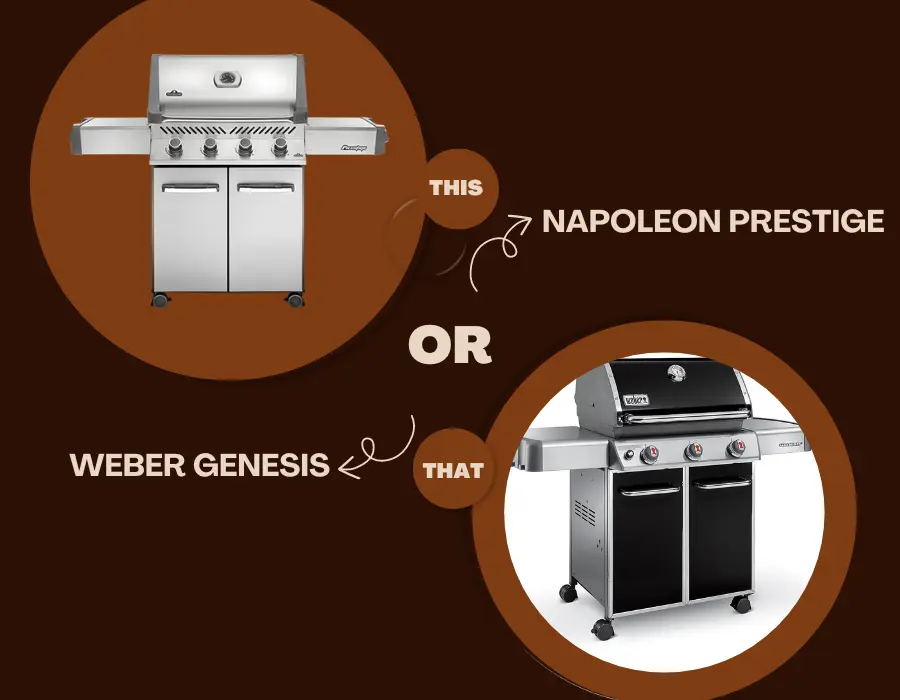This post may contain affiliate links. If you use these links to buy something we may earn a small commission. Thanks.
Choosing between the Napoleon Prestige and Weber Genesis grills can be challenging, as both brands are known for their exceptional build quality and grilling performance. To help you make an informed decision, let’s break down the key differences and similarities between these two popular models.
Design and Build Quality
- Napoleon Prestige: The Napoleon Prestige 500 features a robust design with four stainless steel main burners producing a total of 48,000 BTUs. It also includes an 18,000 BTU infrared rear burner and a 14,000 BTU infrared side burner, known as the Sizzle Zone, which heats up to 1800°F in seconds. The grill’s stainless steel construction ensures durability, and the lift-ease roll-top lid provides excellent heat retention.
- Weber Genesis: The Weber Genesis S-415 is equipped with PureBlu burners designed for even heat distribution across the cooking surface. It also features the signature FLAVORIZER Bars, which catch and vaporize drippings, enhancing flavor and reducing flare-ups. The grill’s stainless steel cooking grates are durable and quick to heat, making it a solid contender in terms of build quality.
Cooking Performance
- Heat Output and Control: The Napoleon Prestige offers a higher total BTU output with its additional infrared burners, making it ideal for high-heat searing and rotisserie cooking. The Weber Genesis, while slightly lower in total BTU output, excels in consistent heat distribution thanks to its innovative burner design and FLAVORIZER Bars.
- Special Features: The Napoleon Prestige includes both an infrared side burner and an infrared rear burner, making it versatile for different cooking styles, from searing to slow-roasting. On the other hand, the Weber Genesis integrates smart technology through Weber Connect, allowing you to monitor grill temperatures and receive notifications via a smartphone app.
Cooking Space and Versatility
- Napoleon Prestige: This grill offers 500 square inches of primary cooking space, plus a warming rack and side burner, providing a total of 760 square inches. This makes it suitable for large gatherings, with the added flexibility of the infrared burners.
- Weber Genesis: The Weber Genesis S-415 provides a slightly larger total cooking area of 787 square inches, including the main cooking surface and the warming rack. It also offers compatibility with the Weber CRAFTED Outdoor Kitchen Collection, which expands the grill’s versatility with accessories like a pizza stone and flat-top griddle.

Ease of Use and Maintenance
- Napoleon Prestige: The JETFIRE ignition system ensures a quick and reliable startup, while the dual-layer sear plates protect burners from drippings and help with even heat distribution. The grill also features a drip tray for easy cleanup.
- Weber Genesis: The Weber Genesis excels in ease of use with its smart grill technology, enabling remote monitoring and precise temperature control. Its Grease Management System and easily accessible grease tray simplify maintenance.
Durability and Build Quality
Both grills are constructed from high-quality stainless steel, ensuring longevity. However, the Napoleon Prestige is known for its sturdier lid design, which provides superior heat retention, while the Weber Genesis stands out for its durable grates and FLAVORIZER Bars, which enhance both durability and grilling performance.
Price and Value
- Napoleon Prestige: This grill tends to be more expensive, reflecting its high-end features such as the infrared burners and rotisserie kit. It offers excellent value for those who need a versatile grill capable of handling a wide range of cooking tasks.
- Weber Genesis: The Weber Genesis is generally priced lower, making it an attractive option for those seeking smart features and reliable performance without breaking the bank. Its compatibility with additional accessories adds further value.
Comparison Table




What to Consider Before Buying a Gas Grill
Grill Size and Cooking Area
- Cooking Surface: Consider how much grilling space you need based on the size of your family or the gatherings you typically host. For example, a grill with 400-500 square inches of cooking space is suitable for most families, while larger gatherings may require 600 square inches or more.
- Compact or Full-Sized Models: Compact models are great for smaller patios or limited space, while full-sized models offer greater cooking space and additional features like side burners.
Heat Output (BTUs)
- BTUs (British Thermal Units): BTUs indicate how much heat a grill can generate. While higher BTU ratings often mean more heat, efficiency is more important. Look for grills with good heat distribution rather than just high BTU numbers. For most home grills, 20,000-50,000 BTUs is typical.
- Infrared Burners: Some grills include infrared burners for high-heat searing, which can be useful for cooking steaks and other meats that need a quick sear.
Material and Build Quality
- Stainless Steel: High-quality stainless steel is durable and rust-resistant, making it ideal for outdoor use. Avoid painted steel parts, as they can rust over time.
- Cooking Grates: Look for stainless steel or porcelain-coated cast iron grates. These retain heat well and are easier to clean compared to plain cast iron, which requires regular maintenance to prevent rust.
Burner Quality and Quantity
- Number of Burners: More burners allow for better heat control and versatility. Three to four burners are typical for mid-range grills, while higher-end models may have up to six burners.
- Burner Material: High-quality stainless steel or brass burners are durable and distribute heat evenly. Aluminum burners tend to wear out faster.
Additional Features
- Side Burners: Useful for preparing side dishes or sauces while grilling.
- Rotisserie Burners: For slow-cooking whole chickens or roasts.
- Warming Rack: Keeps food warm while you finish grilling other items.
- Smart Features: Some modern grills include connectivity options like app-controlled temperature settings or grill monitoring systems (e.g., Weber Connect).
Ease of Maintenance
- Grease Management System: A well-designed system helps channel grease away from burners and makes cleanup easier.
- Removable Parts: Ensure that grates, drip trays, and burners are easy to remove and clean.
Fuel Type
- Propane vs. Natural Gas: Most gas grills use either propane tanks or can be connected to a natural gas line. Propane is portable and convenient, while natural gas is cost-effective for permanent setups. Some grills offer conversion kits to switch between fuel types.
Price and Warranty
Warranty: A longer warranty can be a sign of quality. Look for grills with at least a 5-year warranty on parts like burners and cooking grates.
Budget: Set a realistic budget that aligns with your grilling needs. Basic models can cost $200-$500, while high-end grills with advanced features can go over $1,500.
Frequently Asked Questions: Napoleon Prestige vs. Weber Genesis
Which grill offers better heat output?
The Napoleon Prestige 500 offers a higher total heat output with its four main burners producing 48,000 BTUs, plus an additional 14,000 BTUs from the infrared side burner and 18,000 BTUs from the infrared rear burner. The Weber Genesis S-415, on the other hand, has three main burners with a total output of 39,000 BTUs and an additional 13,000 BTUs for the sear zone. If you need higher heat for searing and rotisserie cooking, the Napoleon Prestige is the better option.
How do the cooking areas compare between the Napoleon Prestige and Weber Genesis?
The Napoleon Prestige 500 provides 500 square inches of main cooking space, with a total of 760 square inches when you include the warming rack and side burner. The Weber Genesis S-415 offers a slightly larger total cooking area of 787 square inches, which includes the main cooking surface and warming rack. Both grills provide ample space, but Weber Genesis offers a bit more cooking area overall.
Does either grill have smart technology features?
Yes, the Weber Genesis S-415 includes Weber Connect smart technology, which allows you to monitor grill temperatures and receive cooking alerts via a smartphone app. This feature is particularly useful for precision cooking. The Napoleon Prestige does not include smart technology features but excels in traditional grilling capabilities, such as high-heat searing and rotisserie cooking.
Which grill is easier to maintain?
Both grills are designed for ease of maintenance. The Weber Genesis features a Grease Management System that simplifies cleanup, along with easily accessible grease trays. The Napoleon Prestige includes a drip tray and dual-layer sear plates that protect burners from drippings, making it easier to keep the grill clean. Both grills are built with stainless steel components that are durable and easy to wipe down.
Are there any significant differences in price?
Generally, the Napoleon Prestige 500 is priced higher than the Weber Genesis S-415 due to its additional features, such as the infrared burners and included rotisserie kit. However, the Weber Genesis offers excellent value, especially if you’re interested in smart grilling technology and slightly more cooking space.
Which grill is better for rotisserie cooking?
The Napoleon Prestige 500 is better suited for rotisserie cooking as it comes with an 18,000 BTU infrared rear burner and a rotisserie kit included with the purchase. The Weber Genesis S-415 offers rotisserie cooking as an option, but the rotisserie kit is sold separately, and it lacks the dedicated infrared burner that the Napoleon Prestige offers.
Can I use additional accessories with these grills?
Yes, both grills support additional accessories. The Weber Genesis is compatible with the Weber CRAFTED Outdoor Kitchen Collection, which includes options like a pizza stone and flat-top griddle. The Napoleon Prestige also offers various accessories, such as a rotisserie basket and infrared burner upgrades. Both grills are versatile and can be customized with additional tools and equipment to enhance your grilling experience.
Conclusion
Both the Napoleon Prestige 500 and Weber Genesis S-415 are exceptional grills that cater to different needs. If you prioritize high-heat searing, rotisserie cooking, and overall versatility, the Napoleon Prestige 500 is the better choice despite its higher price. However, if you value smart technology, ease of use, and slightly more cooking space at a lower cost, the Weber Genesis S-415 is an excellent option.
Your decision should ultimately be based on your specific grilling needs, budget, and whether you prefer traditional grilling features or the latest smart technology.
